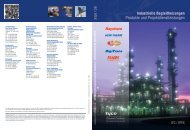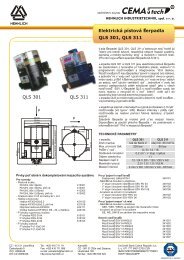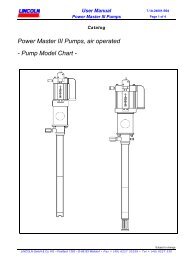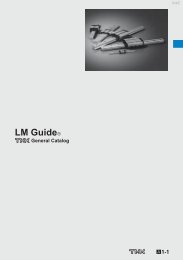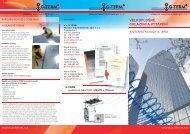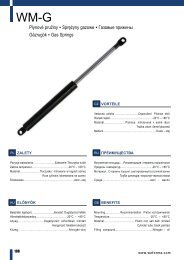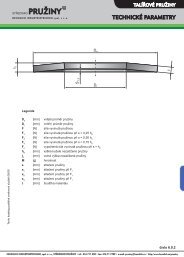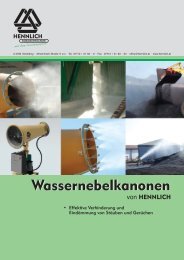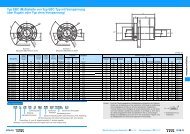Air-Oil Centralized Lubrication Systems - Hennlich
Air-Oil Centralized Lubrication Systems - Hennlich
Air-Oil Centralized Lubrication Systems - Hennlich
You also want an ePaper? Increase the reach of your titles
YUMPU automatically turns print PDFs into web optimized ePapers that Google loves.
<strong>Air</strong>-<strong>Oil</strong> <strong>Centralized</strong><br />
<strong>Lubrication</strong> <strong>Systems</strong><br />
Keep in Motion!<br />
A lubrication system should<br />
always be as modern and<br />
efficient as the machine it's<br />
lubricating.<br />
Lincoln air-oil systems are<br />
ideally suited for this because<br />
they offer:<br />
• Optimal supply to the bearing<br />
• Reduction in lubricant costs<br />
• Environmental friendliness
Index<br />
<strong>Air</strong>-oil <strong>Centralized</strong> <strong>Lubrication</strong> <strong>Systems</strong><br />
<strong>Air</strong>-oil<br />
Single-line System<br />
3<br />
• <strong>Air</strong>-oil Mixing Distributor Valve Type AOl-FL<br />
<strong>Air</strong>-oil<br />
Progressive System<br />
4 – 7<br />
• Progressive Metering Device SSV and SSVD<br />
• <strong>Air</strong>-oil Mixing Block Type MB<br />
• <strong>Air</strong>-oil Metering Device Type ECOFLOW<br />
• EFC Installation Assembly<br />
<strong>Air</strong>-oil <strong>Centralized</strong> <strong>Lubrication</strong> <strong>Systems</strong><br />
Advantages of <strong>Air</strong>-oil<br />
• Reduced lubricant consumption:<br />
Reduction up to 1/100th of the<br />
quantity when compared to<br />
grease lubrication<br />
• Continuous supply with fresh oil<br />
• Increased bearing lifespan<br />
• Positive pressure sealing of the<br />
bearing against contamination<br />
(water, dirt)<br />
Principal<br />
2<br />
• Drastic reduction in<br />
maintenance costs;<br />
no cleaning of grease during<br />
bearing inspection<br />
• No grease contamination of<br />
equipment, the working area<br />
and cooling water<br />
• No misting of oil<br />
• Environmentally friendly by<br />
simple disposal methods<br />
• <strong>Oil</strong> and scale can individually<br />
be disposed of (clean<br />
separation)<br />
Function Principal<br />
<strong>Air</strong>-oil <strong>Lubrication</strong><br />
An oil pump supplies a<br />
progressive or a single-line<br />
metering device with oil. The<br />
metered quantities of oil from the<br />
metering device are supplied to a<br />
mixing block that is connected to<br />
the compressed air network. The<br />
oil droplets in the line to the<br />
bearing are pulled apart in streaks<br />
by the flow of air. The airflow in<br />
the middle of the tube transports<br />
the oil along the inner wall of the<br />
tube. The carrier compressed air<br />
exits the bearing and<br />
simultaneously assists in sealing<br />
the bearing. No oil mist develops.<br />
A continuous, minuscule amount<br />
of oil enters the bearing.<br />
1<br />
Compressed <strong>Air</strong><br />
<strong>Oil</strong><br />
3<br />
1<br />
2<br />
3<br />
Line<br />
<strong>Air</strong>-oil Mixing Block<br />
Bearing<br />
2
<strong>Air</strong>-oil<br />
Single-line System<br />
<strong>Air</strong>-oil Mixing Distributor<br />
Type AOI-FL<br />
Output quantity:<br />
0.025 – 0.65 cm3/stroke<br />
With metering screws in<br />
increments of 0.025; 0.05; 0.1;<br />
0.3; 0.4; 0.5; 0.65<br />
<strong>Oil</strong> pressure: max. 50 bar<br />
Venting Pressure: max. 6 bar<br />
<strong>Air</strong> pressure: 3–6 bar<br />
Monitoring: visual via steel ball<br />
that indicates the stroke of the<br />
distributor<br />
For applications with large<br />
variances in lubricant<br />
requirements per point.<br />
The AOI distributor injector<br />
operates on the single-line<br />
concept. This means, all injectors<br />
are connected via a mainline to<br />
the pump. The mainline is<br />
alternatively pressurized with oil<br />
and vented. Each injector outlet<br />
can be individually metered and<br />
the function is visually monitored<br />
via a steel ball. In addition, the<br />
airflow is adjustable for each<br />
outlet. As a result, the AOI<br />
injectors are especially suited for<br />
systems with lubrication points<br />
that have large variances in<br />
lubricant requirements per point.<br />
Visual monitoring is performed via<br />
a steel ball that externally shows<br />
the piston movement.<br />
Environmental Information<br />
<strong>Air</strong>-oil System<br />
Lincoln air-oil systems with AOI and<br />
Ecoflow distributors, reduce and<br />
accurately meter the lubricant<br />
quantities.<br />
<strong>Air</strong> <strong>Oil</strong> <strong>Air</strong>/<strong>Oil</strong><br />
• Cleaning and disposal cost are<br />
reduced, as grease contamination<br />
of equipment, cooling water and<br />
the sinter is eliminated<br />
3<br />
2<br />
1<br />
• When comparing to oil mist<br />
lubrication, the breathing air is not<br />
contaminated with micro oil<br />
droplets. The macro oil drops<br />
remain in the bearing, thus<br />
avoiding breathing air<br />
contamination.<br />
4 5 6<br />
7<br />
1<br />
2<br />
3<br />
4<br />
Steel ball<br />
Injector<br />
<strong>Air</strong> throttle<br />
<strong>Oil</strong> inlet<br />
5<br />
6<br />
7<br />
<strong>Air</strong> inlet<br />
Mixing block<br />
Outlet air/oil<br />
Lincoln Environmental Declaration<br />
may be found under:<br />
www.lincolnindustrial.de/<br />
Environment<br />
3
<strong>Air</strong>-oil<br />
Progressive System<br />
When several hundred lubrication<br />
points are to be supplied, for<br />
example in continuous casting or<br />
roll-out areas, progressive systems<br />
with mixing blocks and ECOFLOW<br />
metering devices are used.<br />
The air-oil mixture is produced<br />
within the mixing blocks. The<br />
distribution of oil to the mixing<br />
blocks occurs via SSV progressive<br />
metering devices. Depending on<br />
the size of the system, the mixing<br />
blocks are available in two different<br />
sizes. And, when different size<br />
strands are to be lubricated, SSVD<br />
metering devices may be used for<br />
the oil distribution. The air-oil flow<br />
is then distributed to the lubrication<br />
points by ECOFLOW metering<br />
devices - which are also available<br />
in two sizes: "S" (small),<br />
"L" (large).<br />
The large ECOFLOW metering<br />
devices are used as primary units<br />
that supply the smaller metering<br />
devices. This reduces the total<br />
number of mixing blocks, and<br />
provides an even distribution for<br />
large systems.<br />
Both the mixing blocks and the<br />
ECOFLOW metering devices do<br />
not have moving parts, thus<br />
eliminating wear.<br />
MB-4-L MB-4-L MB-4-L MB-4-L<br />
SSVD 8/4<br />
SSVD 8/4<br />
SSVD 8/4<br />
SSVD 8/4<br />
EFM2-B-L<br />
EFM4-B-L<br />
EFM4-B-L<br />
EFM4-B-L<br />
EFM2-B-S<br />
EFM2-B-S<br />
Section 1 Section 2 Section 3 Section 4<br />
<strong>Air</strong><br />
<strong>Oil</strong><br />
<strong>Air</strong>/oil<br />
MB: Mixing Block<br />
EFM: ECOFLOW Metering Device<br />
SSVD: Progressive Metering Device<br />
4
<strong>Air</strong>-oil<br />
Progressive System<br />
Progressive Metering Devices SSV and SSVD<br />
Metering Device SSV<br />
The progressive metering devices<br />
SSV supply the oil in metered<br />
quantities to the mixing blocks.<br />
Number of outlets: 6–22<br />
Monitoring via piston detector<br />
(proximity switch)<br />
Metering Device SSVD<br />
When vastly differing quantities<br />
are required, the SSVD may be<br />
used instead of the SSV. The<br />
SSVD is adjustable per outlet pair<br />
(metering from 0.08 to 1.8 cm3 in<br />
10 increments). The metering<br />
occurs with the metering device<br />
block via metering screws.<br />
<strong>Air</strong>-oil Mixing Block Type MB<br />
The air-oil mixing blocks produce<br />
the air-oil flow. They are available<br />
in 2 sizes: type MB..S and MB..L.<br />
MB..S mixing blocks have 2 to 6<br />
outlets, and the MB..L have 2, 3<br />
or 4 outlets. As a result, various<br />
size strands with different<br />
numbers of lubrication points can<br />
be supplied with a flow of air-oil.<br />
In accordance with the flow rate,<br />
the inlet and outlet port sizes are<br />
different.<br />
Mixing Block MB<br />
Progressive Metering Device SSV<br />
Progressive Metering Device SSVD<br />
with Metering Screws<br />
1<br />
2<br />
1 Compressed <strong>Air</strong> Inlet<br />
2 <strong>Air</strong>-oil Outlet<br />
Mixing Block MB-2-S<br />
5
<strong>Air</strong>-oil<br />
Progressive System<br />
with ECOFLOW <strong>Air</strong>-oil Flow Metering Device<br />
The dividing of the finished air-oil<br />
flow is accomplished with the<br />
ECOFLOW air-oil flow metering<br />
device. The special design<br />
concept avoids the Coanda<br />
Effect* and achieves the desired<br />
split to secondary metering<br />
devices or to the lubrication<br />
points.<br />
<strong>Air</strong>-oil Flow Metering Device Type EFM 5-B-S<br />
Inlets<br />
G 1/4” G 1/2”<br />
<strong>Air</strong>-oil Flow Metering Device Type EFM 2-B-L<br />
Outlets<br />
The ECOFLOW metering devices<br />
are available in 2 sizes "S" (small)<br />
and "L" (large):<br />
The large ECOFLOW metering<br />
devices are used as a primary to<br />
supply the smaller ECOFLOW<br />
metering devices.<br />
The large ECOFLOW metering<br />
devices are available with 2 to 6<br />
outlets, and the small metering<br />
devices with 2 to 8 outlets.<br />
G 1/8” G 1/4”<br />
Model Outlets Model<br />
Outlets<br />
EFM 2-B-L<br />
EFM 3-B-L<br />
EFM 4-B-L<br />
EFM 5-B-L<br />
EFM 6-B-SL<br />
2<br />
3<br />
4<br />
5<br />
6<br />
EFM 2-B-S<br />
EFM 3-B-S<br />
EFM 4-B-S<br />
EFM 5-B-S<br />
EFM 6-B-S<br />
EFM 7-B-S<br />
EFM 8-B-S<br />
2<br />
3<br />
4<br />
5<br />
6<br />
7<br />
8<br />
*Coanda Effect:<br />
The tendency of a stream of fluid to stay<br />
attached to a convex surface. This results in an<br />
undetermined build-up of the oil film on one or<br />
more ports.<br />
6
<strong>Air</strong>-oil<br />
Progressive System<br />
EFC Installation Assembly<br />
EFC installation assembly units are<br />
used for the lubrication of bearings<br />
in rolling mills or straighteners. The<br />
EFC supplies 2, 3 or 4 lubrication<br />
points from a single inlet with an<br />
air-oil flow mixture.<br />
Every assembly consists of a<br />
number of installation cartridges<br />
and spacers.<br />
The special design of the cartridges<br />
enable the air-oil flow to be divided<br />
into the desired portions for each<br />
connected lubrication point. The<br />
spacers are used to match the<br />
length of the assembly to that of the<br />
bearing.<br />
ECOFLOW Installation Assembly Unit<br />
7<br />
6<br />
5<br />
4<br />
3<br />
1<br />
2<br />
1<br />
2<br />
3<br />
4<br />
Strainer<br />
Closure plug<br />
Holding ring<br />
Spacer<br />
5<br />
6<br />
7<br />
Cartridge<br />
Spacer<br />
End Cartridge<br />
7
Lincoln's Global Distribution<br />
and Service Network<br />
The Best in our Industry<br />
Hundreds of Lincoln System Houses are available for you - worldwide<br />
Lincoln Main Locations<br />
Lincoln Offices<br />
(Distributors, Agents & System Houses not shown)<br />
In all levels of service – lubrication<br />
system selection & evaluation,<br />
custom-engineered system<br />
installation, or the supply of topquality<br />
products – the employees<br />
of our Lincoln locations, offices,<br />
agents and distributors make<br />
certain you always get the very<br />
best value.<br />
System House Distributors<br />
Our system house distributors<br />
offer the highest level of expertise<br />
available in the industry.<br />
They custom-design systems<br />
with the exact combination of<br />
Lincoln components required.<br />
Then they install the system at<br />
your facility with experienced<br />
technicians or work with your<br />
personnel to ensure the job is<br />
done correctly. Each distributor<br />
stocks a full inventory of pumps,<br />
metering devices, controllers and<br />
accessories. Each continues to<br />
meet our stringent requirements<br />
for product, systems and service<br />
knowledge. From St. Louis to<br />
Singapore, Walldorf and worldwide,<br />
Lincoln’s top-of-the-industry<br />
system house distributors will<br />
be there when and where you<br />
require them.<br />
For the nearest authorized<br />
Lincoln sales and service<br />
representative, contact:<br />
Americas:<br />
St. Louis, Missouri<br />
Phone +1 314.679.4200<br />
Fax +1 800.424.5359<br />
www.lincolnindustrial.com<br />
DistributorLocator<br />
Europe/Middle East/Africa:<br />
Walldorf, Germany<br />
Phone + 49.6227.33.0<br />
Fax + 49.6227.33.259<br />
www.lincolnindustrial.de<br />
CONTACT<br />
Asia/Pacific:<br />
Singapore<br />
Phone + 65.65880188<br />
Fax + 65.65883438<br />
Lincoln GmbH & Co. KG<br />
Heinrich-Hertz-Str. 2-8<br />
D-69190 Walldorf · Germany<br />
phone + 49.6227.33.0<br />
fax + 49.6227.33.259<br />
lincoln@lincolnindustrial.de<br />
www.lincolnindustrial.de<br />
© Copyright 2006<br />
Printed in Germany<br />
Form W-139-A-0806



